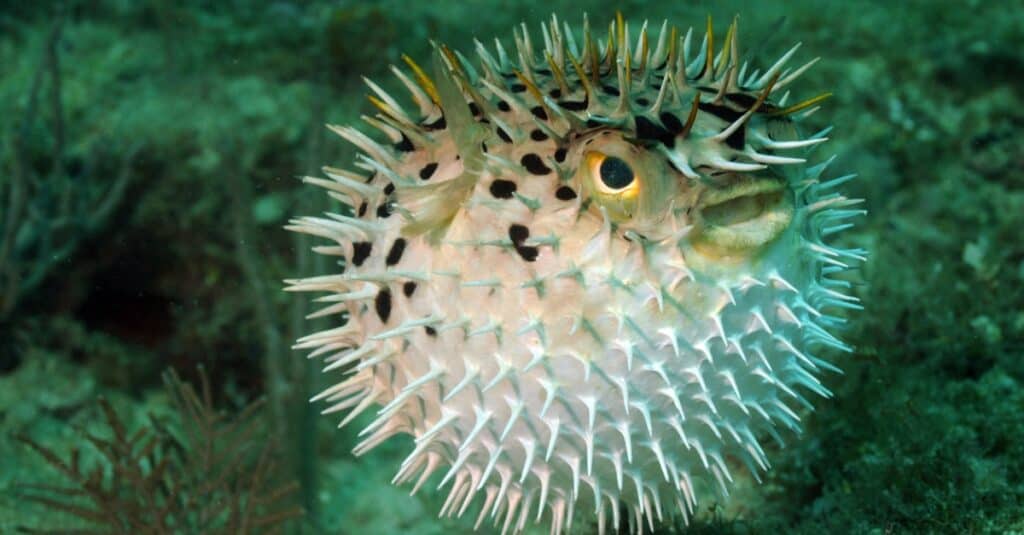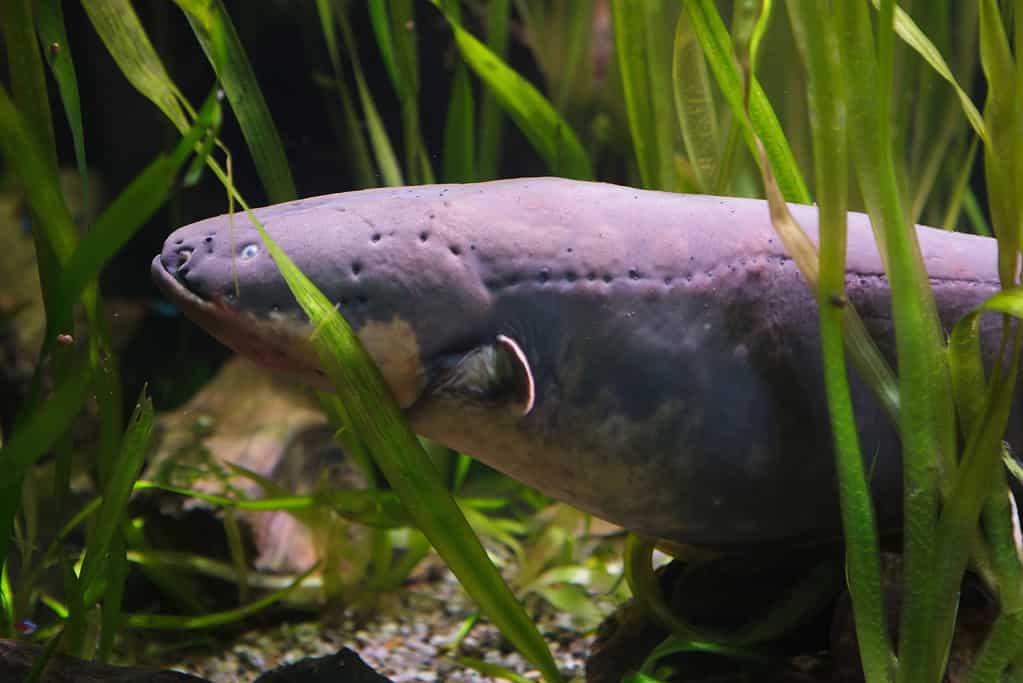They both have lethal capabilities. While one is toxic, the other is quite literally stunning. In an epic sea battle between a poisonous pufferfish vs. an electric eel, which sea creature emerges victorious? Let’s find out!
Comparing a Pufferfish vs. Electric Eel
| Poisonous Pufferfish | Electric Eel | |
|---|---|---|
| Size | Up to three feet long; up to 30 pounds | Six to eight feet; up to 45 pounds |
| Speed and Movement | Slow, clumsy swimmers but can move quickly when they engage their caudal fin | Up to 60 miles per hour |
| Defenses | Puffing up, foul taste, toxic, and sharp spines | Powerful electric discharges of up to 650 volts |
| Offensive Capabilities | Sharp, beak-like teeth, toxic spines | Motion-sensitive hairs, emits electric pulses |
| Predatory Behavior | Open water hunting, ambushing, beak-like front teeth | Suck prey into their mouths, hunt sleeping fish, shocking pulses |
What Are the Key Differences Between a Pufferfish and an Electric Eel?
Between a pufferfish and an electric eel, an electric eel is significantly faster in the water. Not only that, but pufferfish are quite clumsy when they swim. Electric eels have a shape that allows them to move swiftly and a special ability that allows them to shock prey and predators. Pufferfish move more slowly and have their own defense mechanism, which is when they puff up into a ball shape. Sometimes these fish have spines on their bodies that make them look like underwater porcupines.

Pufferfish inflate into a rounded shape when threatened.
©iStock.com/FtLaudGirl
What Are the Key Factors in a Fight Between a Pufferfish and an Electric Eel?
There are a couple of key factors when it comes to a fight between a pufferfish and an electric eel. Their size plays a role and electric eels grow much larger. Their speed and the way in which they move also play a role. Each underwater creature has its own set of defenses — and both can be deadly. When hunting for prey, they are intentional with their abilities. Whereas pufferfish like to ambush, electric eels prefer easy prey like sleeping fish.
Pufferfish vs. Electric Eel: Size
A pufferfish is a rather big fish that can grow up to three feet long and can weigh up to 30 pounds. However, the size of a pufferfish does not compare to the size of an electric eel. An electric eel can grow anywhere between six to eight feet long and can weigh up to 45 pounds. This gives the electric eel an advantage, especially since it doesn’t even need to make contact with a pufferfish to shock it with an electric signal.

A pufferfish is a rather big fish that can grow up to three feet long and can weigh up to 30 pounds.
©Albert kok / CC BY-SA 3.0 – License
Pufferfish vs. Electric Eel: Speed and Movement
If an electric eel is interested in evading a pufferfish, it can do so with ease. A pufferfish wouldn’t even know what just happened. Whereas if an electric eel is headed straight toward a pufferfish, the pufferfish would clumsily puff up and use its defenses but it’s unlikely that an electric eel would try to eat it. A pufferfish’s defenses require touch.
Pufferfish vs. Electric Eel: Defenses
Some pufferfish have sharp spines that protect them from predators. If a predator were to get too close, it would feel the sting of the spines and retreat. Not only that but making contact with a puffer fish means that the electric eel would be touching a toxic part of the puffer fish. An electric eel’s defense is different as it can send electrical discharges of up to 650 volts without even touching the pufferfish!

Electric eels can send electrical discharges up to 650 volts!
©iStock.com/Kseniia Mnasina
Pufferfish vs. Electric Eel: Offensive Capabilities
Pufferfish with spines rely on them to pierce through, releasing a lethal toxic called tetrodotoxin. When they are looking for prey, they go out into the open water to find them. But they may also ambush. Electric eels use weak electrical impulses to help them navigate the water and find prey.
Pufferfish vs. Electric Eel: Predatory Behavior
When a puffer fish is hunting and finds a preferred food source like a crustacean, it uses its beak-like front teeth to snap through the outer shell of the crustacean. These beak-like teeth help them when they’re open water hunting. Electric eels hunt a little bit differently. They don’t have big beak-like front teeth, so they suck their prey into their mouths. They also prefer an easier meal and hunt sleeping fish. They can emit weak electrical signals to help them navigate and stronger electrical signals to stun their prey.

An electric eel will suck prey into its mouth and will often hunt sleeping fish.
©Vladimir Wrangel/Shutterstock.com
Who Would Win in a Fight Between a Pufferfish and an Electric Eel?
In a fight between a pufferfish and an electric eel, an electric eel would certainly win. The fact is the electric eel has the ultimate advantage. It doesn’t even need to get close to the pufferfish to stun it or kill it. Whereas the pufferfish needs a predator to come into contact with it in order for it to use its best offensive capabilities, an electric eel can quickly swim by, send an electrical signal to kill a pufferfish, and be on its way in no time.
The photo featured at the top of this post is ©
Thank you for reading! Have some feedback for us? Contact the AZ Animals editorial team.






